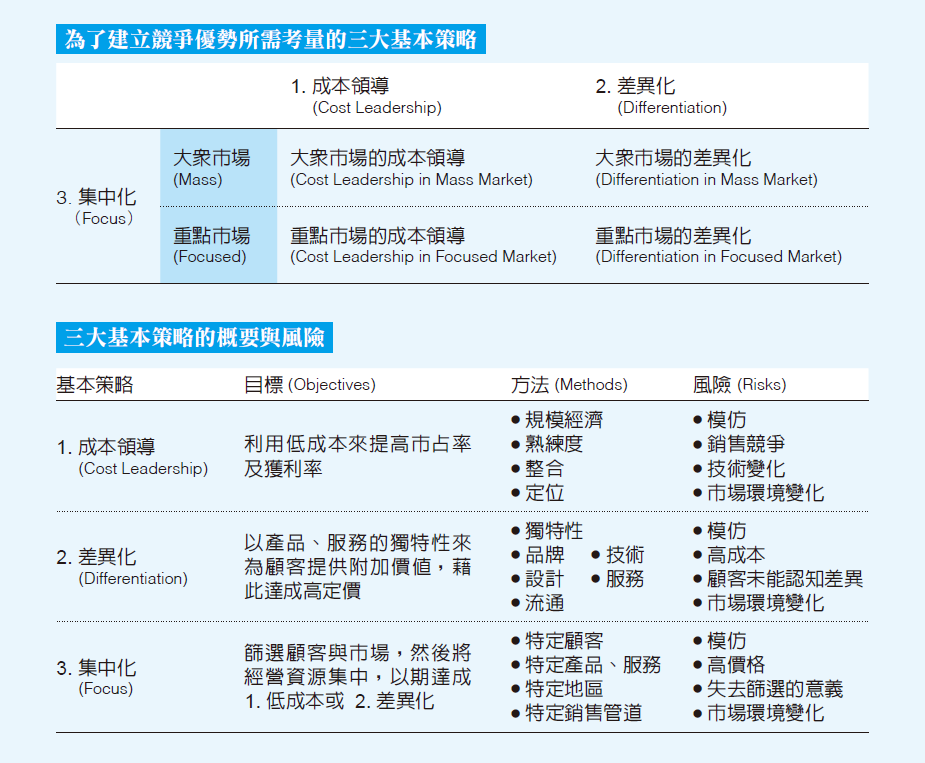Competitive advantage refers to the strategic advantage one company has over its rivals within a particular market.
Companies generally establish such an advantage by either being more cost efficient in their operations or selling a better product (product differentiation). Cost efficiency and differentiation are seen across all industries. Although the two are not mutually exclusive, it is rare to find companies that excel in both. Cost efficiency focuses on “upstream” activities such as SCM (Supply Chain Management), and/or “downstream” activities such as distribution and sales. Dell was a good example of a company that thrived in both areas. Product differentiation requires offering something unique to the customer in terms of the product or buying experience. The difference can be something as superficial as the packaging or design of the product, or simply its brand name. Or, it could be something more meaningful such as the technology that drives the product. Apple has thrived by offering unique products based on proprietary technologies. Whatever the case, differentiation comes down to customer perception. If the customer believes there is value, then it must be true.
● Sustainability and Tradeoffs
In order for a competitive advantage to be successful in the long term it must be sustainable, which means it is difficult for the competition to copy. Companies do this by engaging in an integrated set of activities. For example, Southwest Airlines, a pioneer in the discount airline sector in the US, flies just one type of airplane (Boeing 737), which minimizes operating costs and makes for quicker turnarounds. It also flies into smaller or secondary urban airports which have lower landing fees. It offers no assigned seats or in-flight meals, which again minimizes operating costs. All these things allow Southwest Airlines to be very competitive in terms of pricing.
The major US airlines have tried to copy Southwest Airlines, but have been unable to match them in terms of cost efficiency, primarily because they cannot perform all the necessary activities.
Now, in order for Southwest Airlines (or any other business) to be successful, it must be willing to accept certain “tradeoffs”. These are simply things you may have to give up in order to do something else. For example, if I want to stay up late to watch a movie and I have to get up early the next day for work, lack of sleep would be my tradeoff. By doing what it does, Southwest Airlines is quite successful in the short haul market, with both vacation travelers and business people. However, it is far less successful with longer flights, since multiple stops may be required with fewer amenities offered. And, it is totally absent from the international travel market. These are the “tradeoffs” it has been willing to accept in order to be successful. Unfortunately, many companies tend to forget this simple rule and try to be all things to all people, which usually leads to trouble.
● Niche Market
Some companies focus on niche markets, developing a unique set of skills and competencies that will allow them to become the “expert” in that area. This strategy, if carried out correctly, can result in higher returns (profits) as customers perceive greater value in what the company offers. BMW, for example, has done very well over the years by focusing exclusively on the luxury car market.
競爭優勢是指一家公司在某個特定市場中擁有對手所比不上的策略優勢。
一般而言公司若能建立這樣的優勢,靠的不是提高經營的成本效率,就是販售較好的產品(產品差異化)。成本效率和差異化在各行各業都看得到。雖然兩者並非互斥,但兩項都強的公司卻很少見。成本效率著重的是供應鏈管理 (SCM) 之類的「上游」作業,以及經銷和銷售之類的「下游」作業。以兩方面都做得很成功的公司來說,戴爾是個好例子。產品差異化必須在產品或購買經驗上為顧客帶來獨到之處。差異化可以是表面的東西,比方說包裝或產品設計,或者就是它的品牌名號。它也可以是比較有內涵的東西,比如像推動產品的技術。Apple 成功靠的就是以獨家技術為基礎,提供獨一無二的產品。不管是哪種情況,差異化都是以顧客的感受為準。若顧客認為有價值,那一定準沒錯。
可持續性和取捨
競爭優勢若要長期成功,一定要能持續,也就是說要讓競爭者難以模仿。企業做到這點的方法是,採取一套整合的作業。以美國廉價航空業的先驅西南航空為例,它只飛一種飛機(波音 737)以盡量壓低營運成本,並促使回航加快。它還飛往較小或次要的城市機場,以減少降落費。它不提供指定座位或機上餐點,這一點同樣壓低了營運成本。而這一切的做法使得西南航空在定價方面極具競爭力。
美國的各大主要航空公司曾試圖模仿西南航空,但在成本效率方面卻無法匹敵,主要是因為它們無法做到所有必要的作業。
再來,西南航空(或其他任何企業)如果要成功,它就必須願意接受某些「取捨」。而所謂「取捨」就是為了做到別的事而必須放棄的事。比方說,假如我想要熬夜看電影,而且隔天須早起上班,那缺乏睡眠就會是我的取捨。在做了「取捨」之後,西南航空在短途飛行市場上相當成功,不論是在度假旅客方面和商務人士方面都是如此。不過在較長途的飛行市場中,它的成績就沒那麼亮麗,因為可能必須多停好幾站,而能提供的便利設施也就比較少。另外,在國際旅遊市場上,它則是完全缺席。這些就是它為了成功而願意接受的「取捨」。可惜有很多公司往往忘了這條簡單的規則,試圖滿足所有的人,所以通常會陷入麻煩。
利基市場
有些公司專注於利基市場,發展出一套獨特的技術和能力來讓自己成為那方面的「專家」。這種策略如果執行得當,就能帶來較高的報酬(利潤),因為顧客會覺得公司所賣的東西具有較高的價值。例如 BMW 長年來就做得非常好,它專門聚焦在豪華車的市場上。


